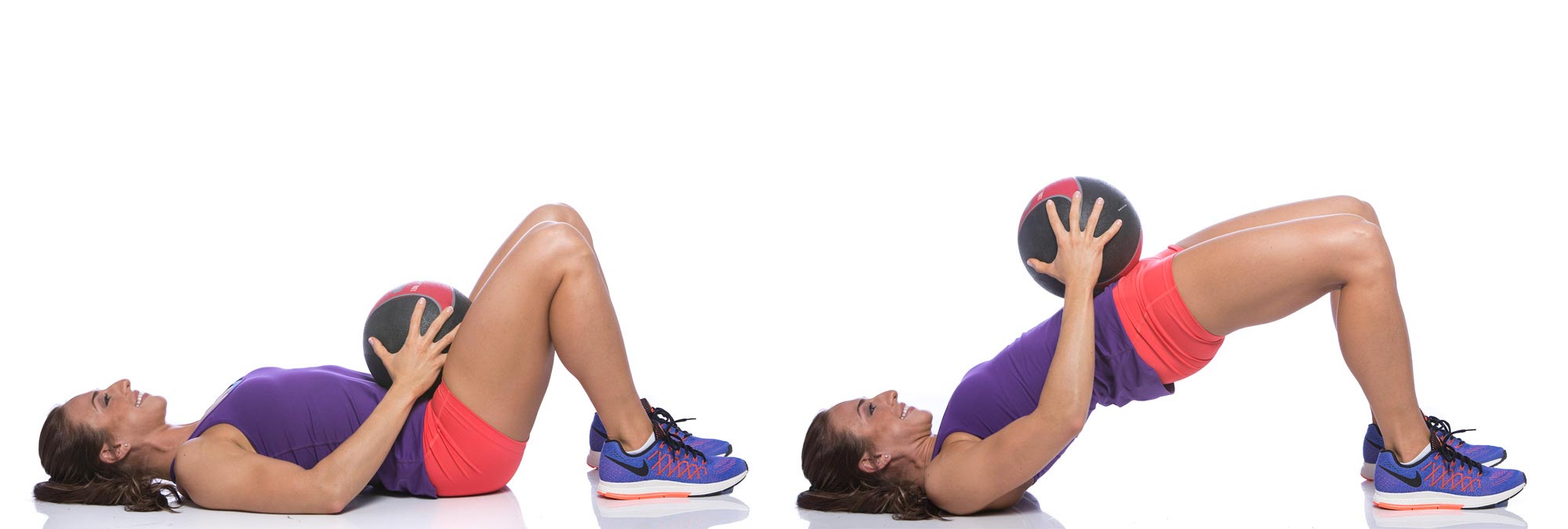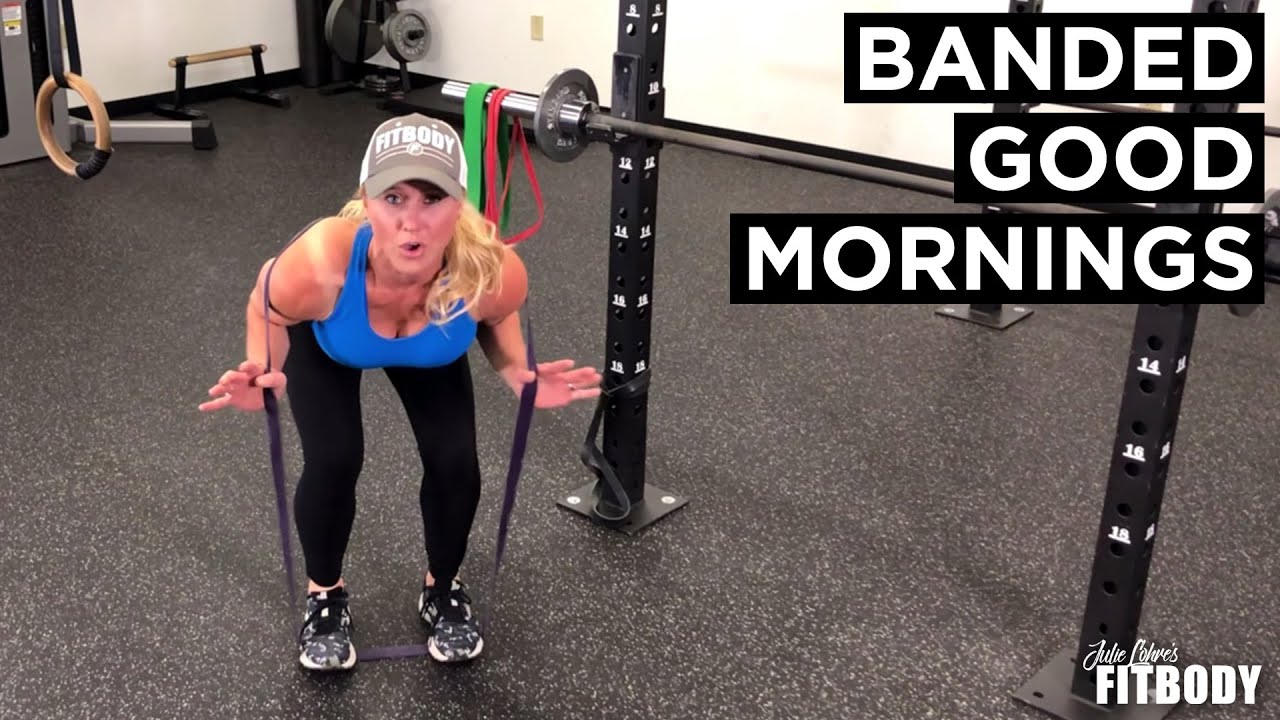Knee Friendly Leg Exercises for Bad Knees
Have you ever stepped into your gym, pumped for a great workout only to be held back by the familiar ache of your knees? Does that whisper of knee pain turn into a full shout when you include traditional favorite leg exercises like deep squats and lunges? Unfortunately, finding knee friendly leg exercises can be super frustrating for many women who want lean and defined legs, but who also struggle with weak or bad knees.

Understanding Knee Problems and Their Impact on Exercise
Causes of Knee Pain During Exercise
– Weak Glutes May Be to Blame
– Stiff Hips Can Cause Knee Stress
– You Might Be Lifting Too Heavy
– Overly Aggressive Workout Progression
– Insufficient Recovery After Intense Training
– Potential Damage or Knee Injury
As a women’s fitness expert with over two decades of experience working directly with women online, I’ve come to appreciate deeply the critical role that leg and glute exercises play not just in our overall fitness but in having the leg shape and definition most women are after. Leg exercises are the cornerstone of a strong lower body, offering benefits that extend far beyond aesthetics. They improve our stability, posture, and even our bone density, which is particularly crucial for women.
However, I also understand that knee issues can pose a significant barrier to embracing these exercises fully. Having suffered three separate ACL tears and subsequent reconstruction surgeries myself, I understand the frustration of trying to find the right leg exercises for bad knees. The good news is, I have done the research for you. In this article, I will be sharing my favorite knee friendly leg and glute exercises specifically for those with knee concerns.
Understanding Knee Problems and Their Impact on Exercise
Knee problems are a widespread concern that can significantly impact one’s ability to engage in regular exercise routines. These issues can arise from a variety of sources, including overuse, injury, or underlying health conditions. Common knee problems include arthritis, a degenerative condition that causes joint pain and stiffness, and tendonitis, an inflammation of the tendons that can lead to pain and mobility issues. Both conditions can make traditional leg workouts painful and, in some cases, detrimental, emphasizing the need for careful exercise selection and modification. The first thing to understand is why you have knee pain. Here are some of the most common reasons women have knee pain…
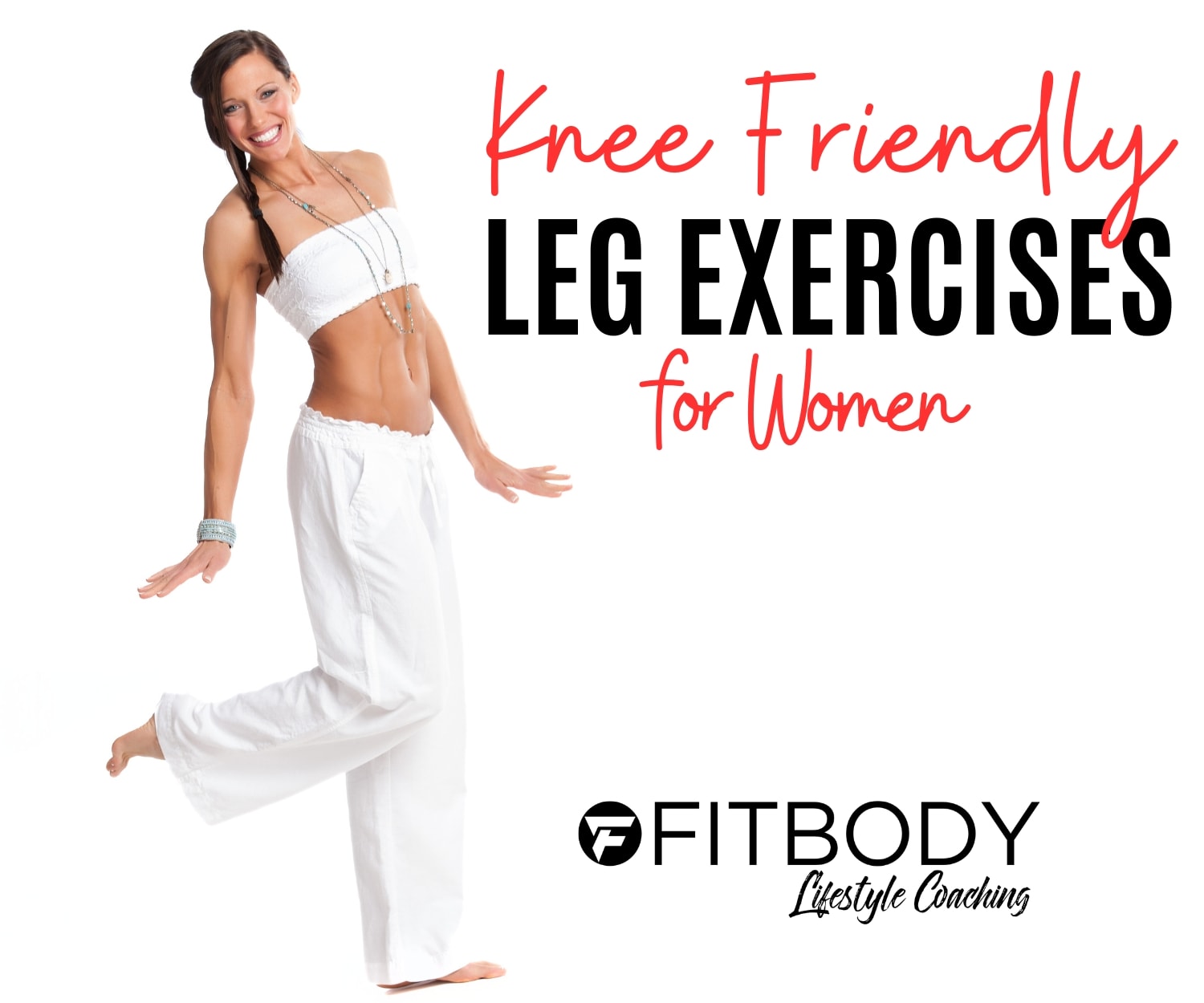
Why Are My Knees Hurting?!?! Causes of Knee Pain During Exercise and Daily Activities
Knee pain and discomfort can arise from various sources during your workouts and everyday routines. Understanding these potential causes is crucial, but this list is not comprehensive. Always seek professional medical advice to pinpoint and treat the specific reasons for your pain.
Reason #1: Weak Glutes May Be to Blame
Weak glutes can lead to knee pain and soreness, especially during lower body exercises. These muscles play a vital role in supporting movements such as squats, lunges, and step-ups. When they’re not strong enough, your knees may take on more strain than they should, leading to increased instability and joint issues. To combat this, focus on strengthening your glutes with exercises designed to enhance muscle without putting extra stress on your knees.
Reason #2: Stiff Hips Can Cause Knee Stress
If your hips lack flexibility, they can’t support the free movement of your femur, placing additional stress on your knee joints. This stiffness forces your knees to compensate, potentially decreasing stability and leading to injuries. Research indicates that increased mobility in the hips can lessen or even prevent knee pain. To improve hip mobility, include stretches like the couch stretch and pigeon holds in your routine, alongside mobility-enhancing exercises such as deep lunges and Cossack squats.
Reason #3: You Might Be Lifting Too Heavy
Lifting weights that are too heavy for you can be a direct path to knee pain. It’s a sign that your joints are under too much pressure. While heavy lifting is not off-limits, moderating the weight and frequency of such workouts can prevent knee discomfort. Opting for lighter weights or less frequent heavy sessions can help you build muscle and strength without compromising your joint health.
Reason #4: Overly Aggressive Workout Progression
Ramping up your workouts too quickly can lead to overuse injuries and knee pain. If you’re increasing your training load or volume too fast, you risk hurting your knees during lower body exercises. The solution is to dial back the intensity and volume of your workouts and possibly introduce more rest days. Monitoring and adapting your training program to suit your body’s needs can prevent injuries and promote long-term progress.
Reason #5: Insufficient Recovery After Intense Training
Failing to properly recover from demanding workouts can lead to knee pain among other issues. This problem stems from inadequate nutrition, poor sleep, and suboptimal workout programming. If you suspect your knee discomfort is due to insufficient recovery, try spacing out your leg workouts more and reducing the volume to allow for better recovery between sessions.
Reason #6: Potential Damage or Knee Injury
In cases of persistent knee pain or discomfort following a traumatic event, structural damage within the knee joint or surrounding tissues may be the cause. Such conditions necessitate professional medical evaluation, including X-rays and MRIs, to accurately diagnose and treat the issue. If you suspect structural damage, consult your doctor promptly to determine the best course of action.
By addressing these potential causes of knee pain, you can take steps to improve your joint health and enhance your overall exercise and daily activity experience. Always consult with a healthcare provider to ensure the most effective and safe approach to managing your knee pain.
Top Knee Friendly Leg Exercises for Bad Knees
When dealing with bad knees, it’s essential to focus on exercises that strengthen the muscles around the knees without putting undue stress on them. I put them into 3 categories: Glute Activators, Hip Hingers, and Quad Strengtheners. Here are my favorite knee friendly leg exercises that are effective for those looking to minimize knee discomfort:
Best Leg Exercises for Bad Knees: Glute Activators like Hip Thrust & Glute Bridges
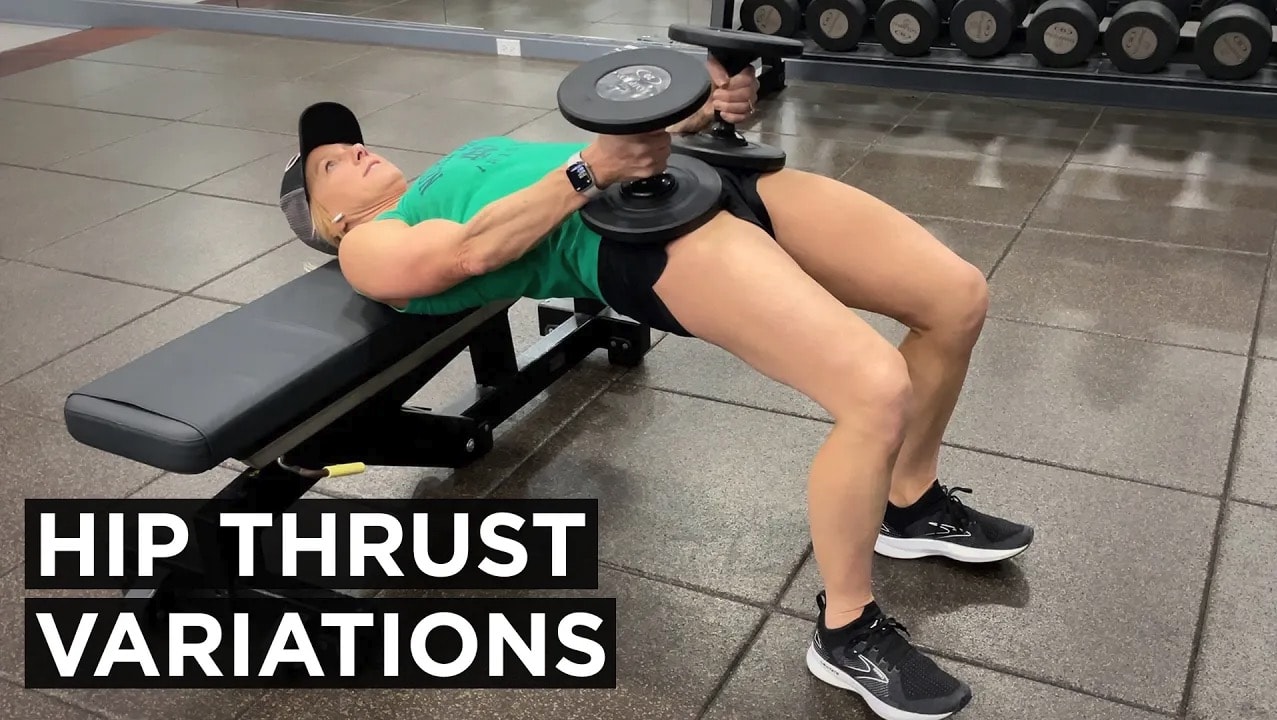
Glute bridges and weighted hip thrusts are my go-to knee friendly exercises for women with bad knees because they target the muscles that play a crucial role in stabilizing and supporting the knee joint, specifically the gluteus maximus and the hamstrings, without placing direct stress on the knees themselves. By strengthening these posterior chain muscles, the exercises help to offload some of the forces that typically go through the knee joint during daily activities or other forms of exercise. This can lead to improved knee stability and a reduction in knee pain over time. Furthermore, both exercises have a relatively low risk of exacerbating knee issues because they involve a hip hinge movement that doesn’t require the knees to bend deeply or bear heavy loads directly.
What is the difference between a hip thrust and a glute bridge? Glute bridges are performed on the ground with body weight or light weight, while hip thrusts are performed with a bench and weights. A hip thrust is basically a glute bridge with a bigger range of motion. Because your back is elevated, there’s a larger range of space between your hips and the ground.
Moreover, glute bridges and weighted hip thrusts are versatile and can be modified to suit various fitness levels and knee sensitivities. These kind of moves are great for those that want to know how to exercise with bad knees to lose weight. For instance, individuals can start with bodyweight glute bridges and gradually introduce weights as they become more comfortable with the movement. This progression allows for strength building in a controlled manner, ensuring the knee joint is protected. The emphasis on the posterior chain not only aids in knee health but also contributes to overall lower body strength and functionality. This can enhance performance in other exercises and daily movements, reducing the risk of knee injuries and other lower body issues in the long run.
Knee Friendly Leg Exercise: Hip Hingers like Good Mornings & Stiff Leg Deadlifts
If you want to lift heavier weights, but your bad knees get in the way, stiff leg deadlifts and good mornings are excellent exercises. I recommend these for women with weak knees because they focus on strengthening the posterior chain, which includes the hamstrings, glutes, and lower back, without placing significant strain on the knee joints. These exercises involve a hip hinge motion, which requires minimal to no bending of the knees, thereby reducing the risk of knee pain or injury during the exercise. Strengthening the muscles in the posterior chain can improve the support and stability around the knee joint, potentially alleviating stress on the knees during both exercise and daily activities. By enhancing the strength and stability of the muscles that support the knees, these exercises can contribute to a decrease in knee pain and an increase in overall knee health.
Additionally, stiff leg deadlifts and good mornings encourage the development of core strength and balance, further contributing to improved posture and body mechanics during physical activity. This can lead to better alignment and distribution of forces through the lower body, reducing the likelihood of placing undue stress on weak knees. Moreover, these exercises can be easily adjusted in terms of weight and range of motion to accommodate varying levels of knee health, allowing individuals to progress at their own pace while minimizing the risk of exacerbating knee issues. By focusing on proper form and gradually increasing the challenge, individuals with weak knees can effectively use stiff leg deadlifts and good mornings to build strength in a safe and supportive manner, contributing to overall lower body functionality and resilience.
Best Leg Exercises for Bad Knees: Quad Strengtheners Bench Step Ups, Straight Leg Raises & Leg Press
Quad-strengthening leg exercises like standing straight leg raises, bench step-ups, and leg press are particularly beneficial for individuals with bad knees due to their focus on strengthening the quadriceps, the muscle group at the front of the thigh that plays a crucial role in knee stability and function. These exercises are designed to target and strengthen the quads without placing excessive stress or impact on the knee joints, making them knee-friendly options for those looking to improve leg strength while managing knee discomfort or injury.
Standing straight leg raises help in gently engaging and strengthening the quadriceps without any bending of the knee, thereby minimizing the risk of pain or injury. Bench step-ups provide a controlled way to enhance quad strength and improve balance and coordination, with the added benefit of engaging the muscles in a functional movement pattern that mimics everyday activities. The leg press allows for adjustable resistance and a fixed movement path, which helps in isolating the quads while also offering the ability to control the range of motion to avoid overextending the knee.
These exercises contribute to a stronger muscular support system around the knee, effectively absorbing shocks and reducing the load that the knee joint has to bear during both exercises and daily movements. This not only helps in alleviating current knee pain but also in preventing further knee issues. Additionally, by improving quad strength, these exercises aid in enhancing overall leg function, which can lead to improved mobility and a higher quality of life for individuals with knee problems. Their adaptability in terms of intensity and range of motion makes them suitable for a wide range of individuals, from those just starting their fitness journey to those looking to maintain strength without exacerbating knee conditions.
Avoid these moves! Worst Leg Exercises for Knees:
I would be remiss if I did not share some of the leg exercises that are the worst for women that already have knee issues and knee pain according to the research. While the exercises above give you ways of how to exercise with bad knees to lose weight and get fit, certain traditional weight training leg exercises can exacerbate pain or discomfort due to the stress they place on the knee joint. While everyone is different and what feels right to people can vary, the following exercises are should be approached with caution or avoided altogether by those with bad knees:
- Deep, Heavy Squats: Squatting deeply can put significant strain on the knee joints, especially when done with heavy weights. This can lead to increased pain or injury for those with existing knee issues.
- Leg Press with Deep Knee Bend: Similar to deep squats, using a leg press machine and bending the knees deeply (past 90 degrees) can place a lot of stress on the knees, potentially exacerbating knee problems.
- High-Impact Jumping Exercises: Exercises like box jumps or jump squats involve sudden and forceful impacts on landing, which can be harsh on the knee joints, leading to increased pain or injury.
- Lunges : Lunges, especially when performed with heavy weight, can create stress on the knees during the downward phase of the exercise. This is particularly true if the knee of the forward leg extends far beyond the toes.
- Heavy Leg Extensions: While leg extensions isolate the quadriceps, performing them with heavy weights can put undue stress on the kneecap area and the ligaments, potentially leading to aggravation of knee issues.
- Full-Range Leg Curls: Although leg curls target the hamstrings and are generally safe, performing them with heavy weights or through an excessively full range of motion can sometimes place unwanted stress on the knee joint.
- Hack Squats: The hack squat machine positions the body in a way that can put considerable stress on the knees, especially when performed with heavy weights or too deep of a movement.
If you have knee issues but still want to engage in leg training, it’s crucial to focus on maintaining proper form, using an appropriate range of motion, and selecting exercises that don’t exacerbate knee pain. It’s also beneficial to include exercises that strengthen the muscles around the knees to provide better support and stability for the joint.
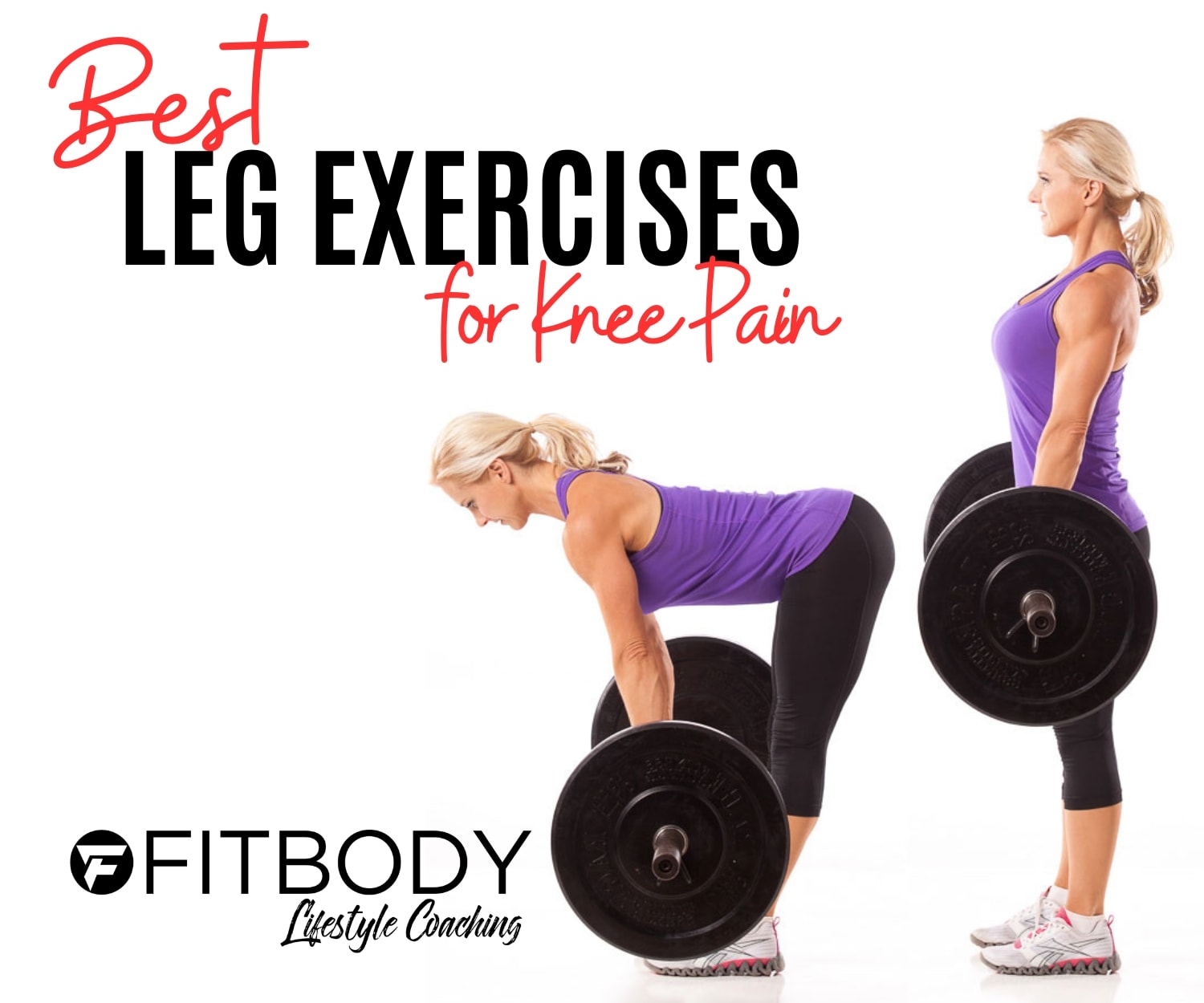
Frequently Asked Questions
Q. How do I workout my legs with bad knees?
A. Exercising your legs without exacerbating knee pain involves selecting low-impact exercises that strengthen the muscles around your knees, which reduces strain on the joint itself. My key strategies include focusing on exercises that enhance the stability and strength of your quadriceps, hamstrings, glutes, and calves without putting undue pressure on your knees. I am often asked how to exercise with bad knees to lose weight. I encourage my online fitness coaching and weight loss clients to opt for activities like cycling on a stationary bike with low resistance and using an elliptical machine, which are gentle on the joints. Strength training exercises such as seated leg presses, straight-leg lifts, and step-ups can also be beneficial, as long as they are performed with correct form and light to moderate weight to avoid overloading the knees. Additionally, incorporating exercises that improve flexibility and balance, like yoga and Pilates, can help maintain knee health by ensuring your legs are well-supported by a strong and flexible musculoskeletal system.
Q. What is the best leg exercise to strengthen knee?
A. If I had to choose just one best leg exercise to strengthen the area around the knee and promote joint health is the bench step-up. This versatile, low-impact movement targets the quadriceps, hamstrings, and glutes, which are key muscle groups for knee stability. By stepping up onto a bench or platform and alternating legs, you not only work on muscle strengthening but also improve balance and joint mobility. Bench step-ups can be easily adjusted to fit your fitness level by varying the height of the step and adding weights as you become stronger. The best part of the step up is that it mimics everyday movements which helps reinforce the knee’s natural function and reduces the risk of injury. Make sure you are doing this one with proper form by keeping your knee aligned over your foot and not extending it past your toes during the movement. That will maximize the benefits and prevent strain on the knee joint.
Q. Why it is Important to Include Knee Friendly Leg Exercises When You Have Knee Pain?
A. When dealing with knee problems, it might seem like you should totally avoid leg exercises. While that can be the cause in the acute period immediately after an injury, most sports medicine doctors encourage continuing to exercise and note that totally cutting out activity can be detrimental. The key in to select knee-friendly exercises that will avoid exacerbating existing conditions. I encourage my online fitness coaching clients with bad knees or knee pain to avoid high-impact activities or exercises that place a significant strain on the knees, such as deep squats or high jumps, as these can worsen pain and inflammation. Instead, we opt for low-impact alternatives that provide the benefits of strengthening and conditioning without the added stress on the knee joints. By doing so, women are able to continue exercising, while minimizing the risk of injury.
Q. How can I Strengthening my Leg and Glute Muscles to Support my Knees?
A. Strengthening the muscles around the knees, particularly the leg and glute muscles, plays a critical role in supporting and stabilizing the knee joints. Strong quadriceps and hamstrings can take some of the loads off the knee joints during daily activities and exercise, reducing pain and the risk of injury. Similarly, well-conditioned glute muscles contribute to better alignment and function of the entire leg, which can alleviate stress on the knees. Engaging in targeted exercises to build strength in these areas can not only help mitigate the symptoms associated with knee problems but also improve overall mobility and quality of life.
Q. Should I Exercise If I Have Knee Pain? How To Exercise With Bad Knees To Lose Weight.
Engaging in regular, knee-friendly exercise is not just about managing symptoms but also about contributing to the long-term health and functionality of the knee joints. Physical activity helps lose weight or maintain a healthy weight, reducing the load on the knees, and promotes the circulation of synovial fluid, which nourishes and lubricates the joints. Additionally, strengthening leg exercises for those with bad knees increases the resilience of the muscles and ligaments surrounding the knee, providing a protective effect against injuries and wear and tear. Therefore, incorporating appropriate knee friendly leg exercises into your routine is a proactive step towards maintaining knee health and preventing further deterioration.
Appendix
Urquhart, Donna M, et al. “The Effect of Physical Activity on the Knee Joint: Is It Good or Bad?” British Journal of Sports Medicine, U.S. National Library of Medicine, Sept. 2007, www.ncbi.nlm.nih.gov/pmc/articles/PMC2465407/.
Bennell, Kim L, et al. “The Effects of Hip Muscle Strengthening on Knee Load, Pain, and Function in People with Knee Osteoarthritis: A Protocol for a Randomised, Single-Blind Controlled Trial.” BMC Musculoskeletal Disorders, vol. 8, no. 1, Dec. 2007
Kim, Eun-Kyung. “The Effect of Gluteus Medius Strengthening on the Knee Joint Function Score and Pain in Meniscal Surgery Patients.” Journal of Physical Therapy Science, vol. 28, no. 10, 2016, pp. 2751–2753, https://doi.org/10.1589/jpts.28.2751.
Urquhart, Donna M, et al. “The Effect of Physical Activity on the Knee Joint: Is It Good or Bad?” British Journal of Sports Medicine, vol. 41, no. 9, 1 Sept. 2007, pp. 546–547, https://www.ncbi.nlm.nih.gov/pmc/articles/PMC2465407/


